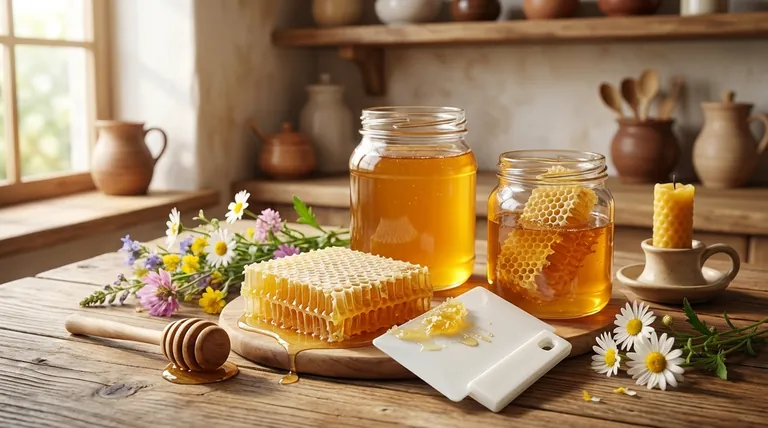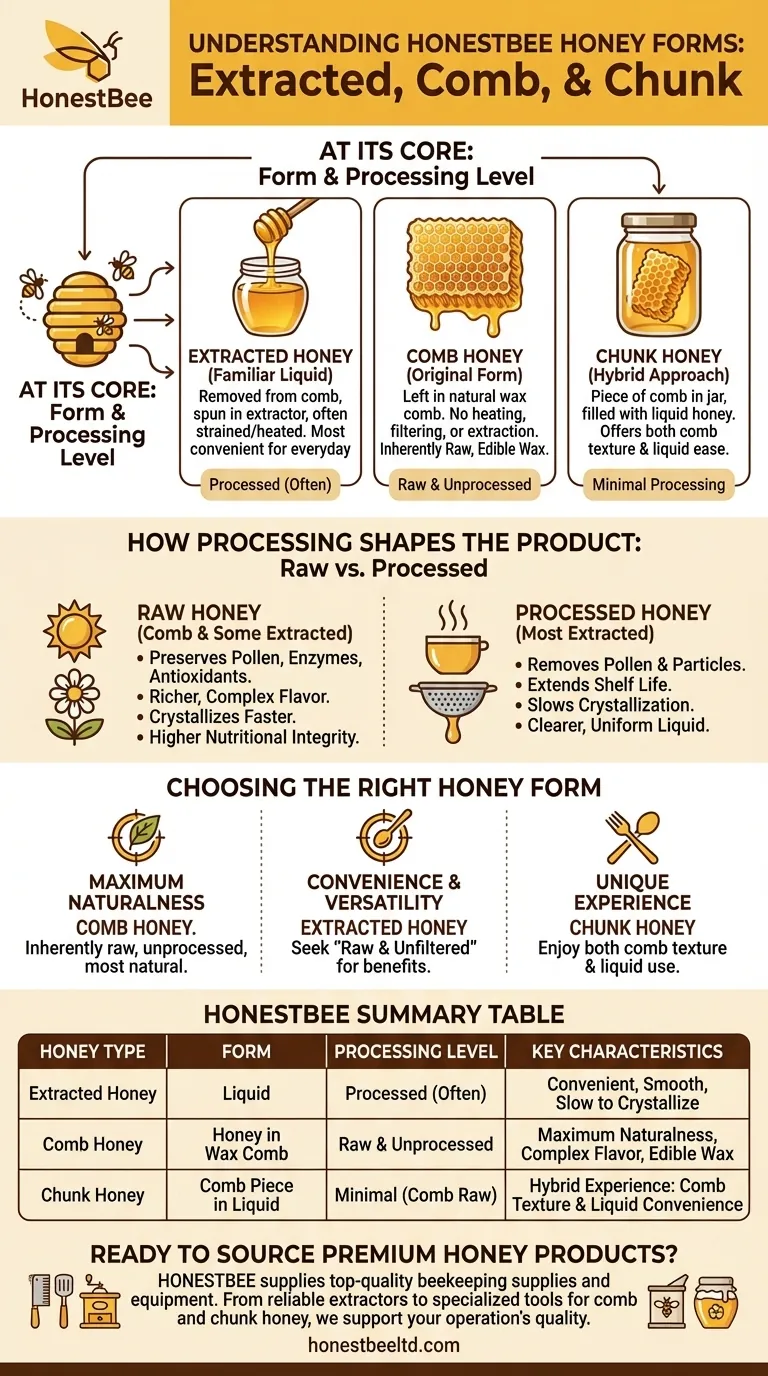At its core, the difference between these honey types lies in their form and level of processing. Extracted honey is the familiar liquid form, removed from its comb. Comb honey is honey left in its natural, edible wax comb. Chunk honey is a hybrid, featuring a piece of the wax comb submerged in a jar of liquid honey.
The fundamental choice is not just between liquid, solid, or a mix. It's a choice about how close to the hive you want the product to be, as the form dictates the processing method, which in turn impacts flavor, texture, and nutritional integrity.

A Closer Look at Each Honey Type
To understand the practical differences, we must examine how each type is produced and what that means for the final product you consume.
Extracted Honey: The Familiar Liquid
Extracted honey is what most people picture when they think of honey. It is harvested by spinning frames of honeycomb in a centrifuge, a machine called an extractor, which flings the liquid honey out of the wax cells.
This liquid honey is then typically strained and bottled. It offers the most convenience for everyday use, from sweetening tea to baking.
Comb Honey: The Original Form
Comb honey is the most natural and unprocessed form available. It is simply a section of the honeycomb cut directly from the frame, full of honey, just as the bees created it.
The entire product is edible, including the beeswax comb, which has a unique, subtly chewy texture. Because it undergoes no heating, filtering, or extraction, it is inherently raw.
Chunk Honey: A Hybrid Approach
Chunk honey attempts to offer the best of both worlds. A beekeeper places a piece of high-quality comb honey into a jar and then fills the rest of the jar with liquid extracted honey.
This gives you the visual appeal and textural experience of eating the comb while also providing liquid honey for easy use.
How Processing Shapes the Final Product
The distinction between "raw" and "processed" is critical when evaluating honey, and it is directly tied to the honey's form.
The "Raw" Advantage
Raw honey is honey that has not been heated (pasteurized) or filtered. This preserves naturally occurring components like pollen, enzymes, and antioxidants.
These elements contribute to a richer, more complex flavor profile and are associated with many of honey's potential health benefits. All comb honey is raw by its very nature.
The "Processed" Rationale
Most commercially available extracted honey is processed. Pasteurization (heating) and fine filtering are done for specific commercial reasons.
This processing destroys yeast cells, slows down crystallization, and removes pollen and other microscopic particles. The result is a clearer, more uniform liquid with a very long shelf life, which is desirable for retail consistency. However, this process also removes many of the beneficial compounds.
Understanding the Trade-offs
Each type of honey presents a different set of characteristics. Choosing between them involves balancing convenience, texture, and your desire for a natural product.
Flavor and Texture
Extracted honey is smooth and consistent. Comb honey provides a more complex experience; the flavor is often more nuanced, and the edible wax adds a unique texture. The flavor of the wax itself can vary depending on the floral source.
Crystallization
Crystallization is a natural process where honey solidifies. Because raw honey contains particles of pollen and propolis that act as starting points for crystals, it crystallizes more quickly. Processed honey, with these particles filtered out, remains liquid for much longer. Many people see crystallization as a sign of high-quality, unprocessed honey.
Purity and Integrity
By definition, comb honey cannot be adulterated. You are seeing the honey exactly as it was sealed in the comb by the bees. While most extracted honey is pure, its liquid form makes it more susceptible to potential modification or dilution in the global supply chain.
Making the Right Choice for Your Goal
Your ideal choice depends entirely on what you value most in the product.
- If your primary focus is maximum naturalness and nutritional integrity: Choose comb honey, as it is inherently raw and unprocessed.
- If your primary focus is convenience and versatility for daily use: Choose extracted honey. Seek out a "raw" and "unfiltered" label if you want more benefits than a standard processed honey.
- If your primary focus is a unique culinary experience: Choose chunk honey to enjoy both the texture of the comb and the convenience of liquid honey in one jar.
Ultimately, understanding these forms empowers you to select the honey that best aligns with your taste, use, and health preferences.
Summary Table:
| Honey Type | Form | Processing Level | Key Characteristics |
|---|---|---|---|
| Extracted Honey | Liquid | Processed (often pasteurized & filtered) | Convenient, smooth, slow to crystallize |
| Comb Honey | Honey in edible wax comb | Raw & Unprocessed | Maximum naturalness, complex flavor, edible wax |
| Chunk Honey | Comb piece in liquid honey | Minimal (comb is raw) | Hybrid experience: comb texture & liquid convenience |
Ready to Source Premium Honey Products?
As HONESTBEE, we supply top-quality beekeeping supplies and equipment to commercial apiaries and distributors. Whether you need reliable extractors for liquid honey or specialized equipment for producing pristine comb and chunk honey, we provide the wholesale solutions to support your operation's quality and efficiency.
Contact us today to discuss your specific needs and how our products can help you meet the growing demand for diverse, high-integrity honey.
Visual Guide

Related Products
- Professional Wide Blade Honey Scraper for Beekeeping and Honey Processing
- 2 Frame Stainless Steel Manual Honey Spinner Extractor for Beekeeping
- 10L Stainless Steel Electric Honey Press Machine
- HONESTBEE 72 Frame Industrial Electric Honey Extractor for Beekeeping
- Honey Wax Separating Wax Press with Metal Screw Wax Separator Machine
People Also Ask
- Why is uncapping necessary in honey harvesting? Unlock Your Honey Yield & Preserve Comb
- Why is my honey frame not capped? Your Guide to Perfectly Ripe Honey
- What tools are available for uncapping honey? A Guide to Choosing the Right Tool for Your Operation
- What other tools are available for honey uncapping besides knives? Find the Right Tool for Your Apiary's Scale
- What equipment do you need to make honey? A Complete Guide to Starting Your Apiary



















